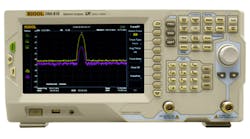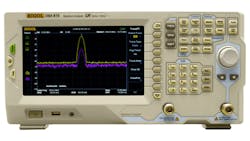Screening through Spectrum Analyzers
Spectrum analyzers have long been among the most useful and versatile of RF/microwave instruments. Engineers working at higher frequencies have grown accustomed to the spectrum display of signal amplitude glowing across a particular measurement bandwidth and a designated frequency range. The instrument has sometimes been described as a receiver with a display screen, and that simply but clearly offers its capabilities (with an antenna or other probe): to tune across a bandwidth in search of different signals.
For anyone old enough to remember, most RF/microwave spectrum analyzers started out as large and heavy desktop or rack-mount units, with limited analysis bandwidths, frequency ranges, and dynamic ranges. But a firm that has long been an innovator in this part of microwave test, Tektronix, shook up the industry with the introduction of their 492 and 494 spectrum analyzers. They were “portable” by measure of their carry handles, although they were certainly not lightweight by modern standards for portability. But in the 1980s, these also represented some of the first test instruments that didn’t sacrifice performance for portability. Over time, spectrum analyzers have become available in smaller packages and can now be found running on battery power, in lightweight units, and even as software-based instruments running on a PC. In addition, they are integrated with other instruments, such as digital oscilloscopes, within the same enclosure for heightened measurement power from a small package.
The different shapes and sizes of the instruments don’t change the value of the instruments to this and many other industries. They are used in many civilian applications for spectrum monitoring and analysis as well as many measurements critical to the development and approval of electronic products, including for electromagnetic-interference (EMI) and radio-frequency-interference (RFI) measurements. They are used by the military to detect the presence of radio-based threats, and by government organizations such as the Federal Communications Commission for tracking and monitoring interference and legitimate radio signals (such as from broadcast stations).
The first thing that most people see on a spectrum analyzer is the screen, and the display screen is certainly an important part of using a spectrum analyzer, whether it is a standalone instrument with its own screen or a PC-based instrument that relies on a PC’s display monitor. The display should provide sufficient resolution to detect and decipher different signal phenomena for a given displayed bandwidth. For portable and outdoor units, the display must overcome the added challenge of presenting test results clearly even in sunlight. But a suitable display is a single starting point in a “checklist” of requirements that can be reviewed when considering adding a new or used spectrum analyzer.
Of course, the display is just a starting point when searching for a spectrum analyzer. A checklist can be created when in the market for an instrument based on the performance requirements for different applications, including frequency range, amplitude range or dynamic range, frequency accuracy, amplitude accuracy, minimum displayed average noise level (DANL), phase noise, minimum resolution bandwidth (RBW), and even the size of the instrument. Often, the quest for gaining the best specifications possible for these performance parameters, such as the difference between a 1-GHz spectrum analyzer and a 10-GHz spectrum analyzer, will come down to price, with performance generally a function of price. The proven names in spectrum analysis, including Tektronix, Keysight Technologies, and Rohde & Schwarz, provide fair prices for their products but often with performance levels that may simply exceed the requirements of some applications. Additional companies have emerged with lower-cost (lower-performance) spectrum analyzers, such as the model DSA800 from Rigol. With a frequency range of 9 kHz to 1.5 GHz, this is one of the lower-costing RF spectrum analyzers on the market, for less than $1,500.
In some cases, the need for a spectrum analyzer may be temporary, such as a search for an interference source. Fortunately, a wide range of RF/microwave spectrum analyzers are currently available to rent or buy secondhand, from a number of dependable suppliers of rental test equipment, including Electro Rent and TestEquity. Such firms offer well-maintained equipment and are generally helpful in guiding a customer through matching the needs of an application to the specifications of the spectrum analyzer.

